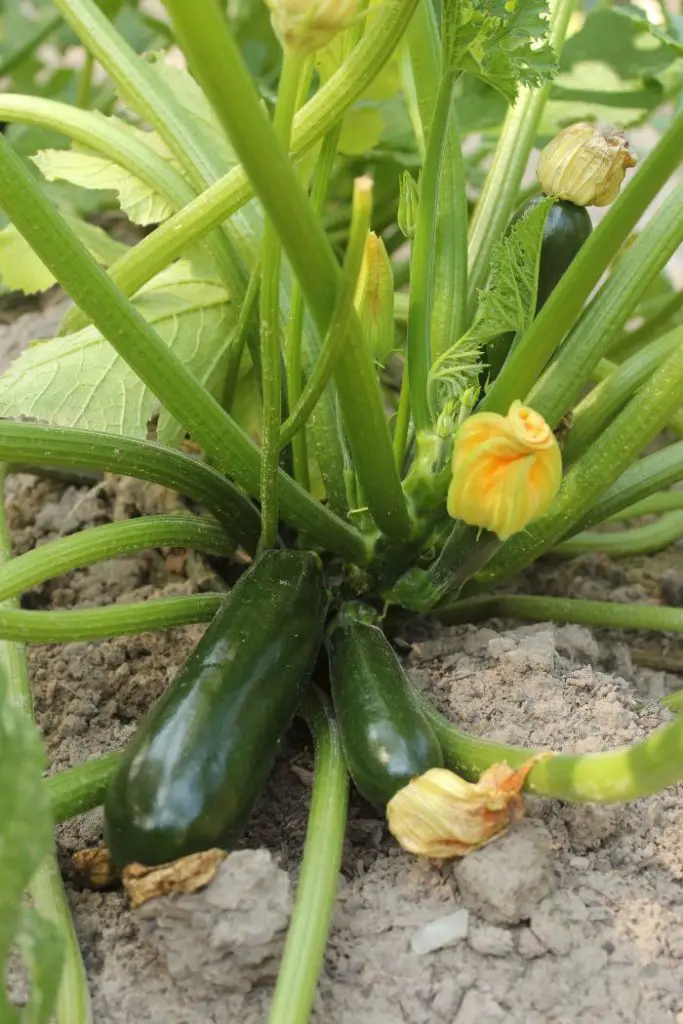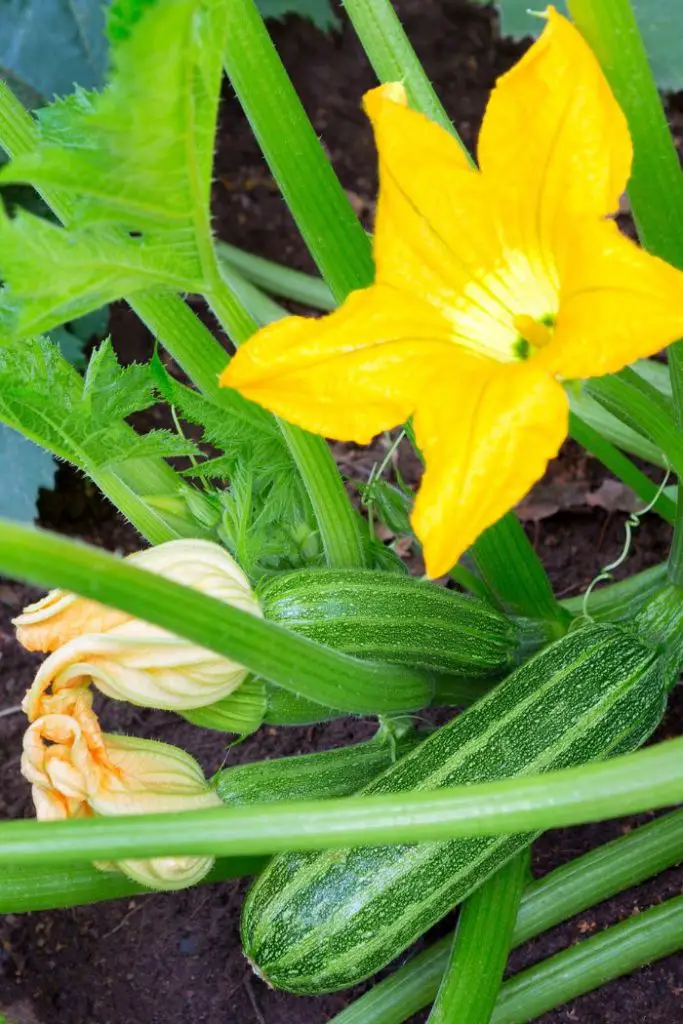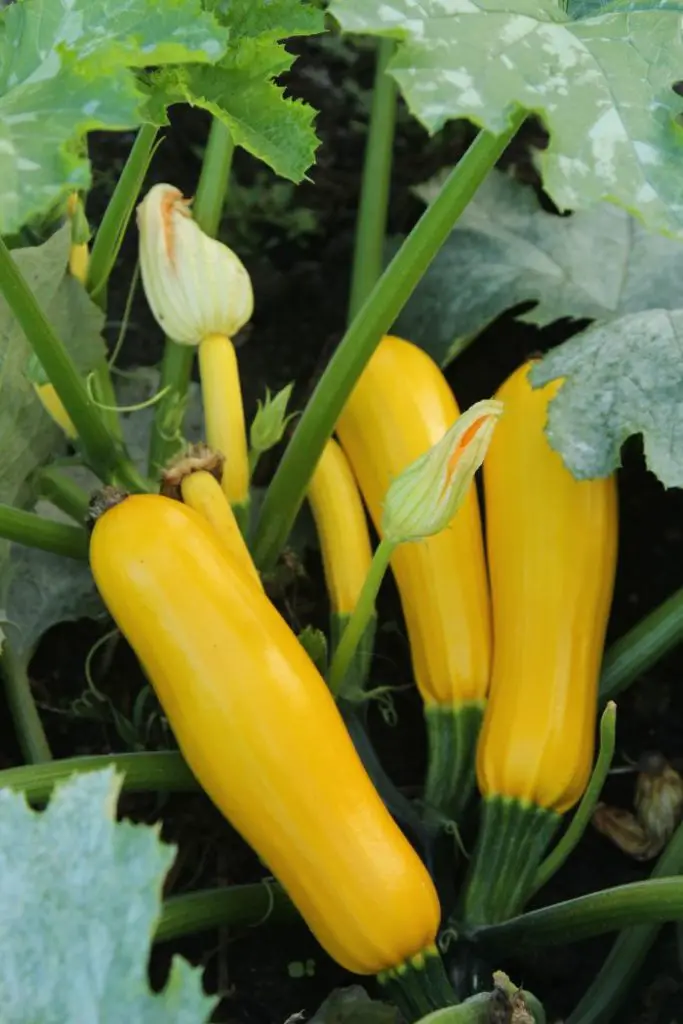As you start growing zucchinis, you’ll want to steer clear of common mistakes that can make all the difference between a bountiful harvest and a disappointing yield.
You might be unaware of the pitfalls that can sabotage your efforts, from neglecting soil prep to improper harvesting techniques.
By recognizing these missteps, you can take proactive steps to guarantee your plants thrive. So, what are the top mistakes to avoid, and how can you set your zucchinis up for success?
Let’s take a closer look at the most critical errors to sidestep on your path to a fruitful harvest.

Key Takeaways
- Neglecting soil preparation and pH testing can hinder zucchini growth and lead to nutrient deficiencies and poor yields.
- Insufficient sunlight exposure (less than 6 hours) can cause stunted growth, reduced yields, and poor fruit quality.
- Inconsistent watering routines can lead to stress, disease, and root rot, so monitor soil moisture and water when dry.
- Failing to provide adequate spacing (2-3 square feet) can reduce yields, invite pests and diseases, and hinder air circulation.
- Neglecting crop rotation can lead to persistent pests and diseases, reducing soil health and zucchini harvest quality.
Insufficient Soil Preparation
When you neglect to prepare the soil adequately, your zucchini plants may struggle to thrive, and it’s often a lack of organic matter and essential nutrients that hinders their growth.
To avoid this, it’s important to test your soil to determine its pH level and nutrient content. Soil testing will help you identify areas that need improvement, allowing you to take corrective action.

One of the most effective ways to enhance soil quality is by adding compost. Compost benefits your zucchini plants by providing a slow release of nutrients, improving soil structure, and supporting beneficial microbial activity.
By incorporating compost into your soil, you’ll create a fertile environment that promotes healthy root development, strong stem growth, and increased yields. Additionally, compost helps retain moisture, reducing the need for frequent watering.
Inadequate Sunlight Exposure
Inadequate sunlight exposure can severely impede your zucchini plants’ growth, as they require at least six hours of direct sunlight per day to undergo photosynthesis and produce sugars that fuel their development. Without sufficient sunlight, your plants will struggle to thrive, leading to stunted growth, weakened immune systems, and reduced yields.
You must make sure your zucchini plants receive the necessary sunlight hours to optimize their growth. If you’re planting in a shaded area, consider relocating to a sunnier spot or using reflective surfaces to amplify available sunlight.
Keep in mind that zucchinis have low shade tolerance, so even partial shading can hinder their growth. Be mindful of nearby structures, trees, or other plants that may cast shade on your zucchini bed. If you can’t provide full sun, aim for at least four hours of direct sunlight and supplement with grow lights if necessary.
Inconsistent Watering Schedule
When you’re growing zucchini, it’s important to establish a consistent watering schedule.
If you’re not careful, you’ll either underwater or overwater your plants, leading to stunted growth or root rot.
You’ll need to find a balance, as both scenarios can be detrimental to your zucchini’s health.
Watering Too Little
Maintaining a consistent watering schedule is crucial for the growth and yield of your zucchini plant. Inconsistent watering can result in water stress, weakening the plant and making it more susceptible to disease. Prolonged dry periods can lead to soil cracks, compounding the issue.
As a zucchini grower, establishing a regular watering routine that suits your plant’s requirements is vital. Monitor the soil moisture daily and water your zucchini plant when the top 2-3 inches of soil are dry to the touch. Aim to provide around 1-2 inches of water per week, whether from rainfall or irrigation. Avoid wetting the leaves to prevent fungal infections.

Watering Too Much
Overwatering your zucchini plant can be just as detrimental as underwatering, as it can lead to root rot and other problems if the soil is consistently waterlogged. When you water your zucchini plant too much, you’re creating an environment that’s conducive to root rot. This is because excess water can cause the roots to suffocate, leading to a breakdown of the plant’s ability to absorb nutrients and water. As a result, your zucchini plant may start to wilt, turn yellow, or develop black spots.
To avoid this, you need to establish a consistent watering schedule. Check the soil daily, and only water when the top inch of soil feels dry to the touch. Avoid getting water on the leaves to prevent fungal diseases. Instead, water at the base of the plant, allowing the soil to absorb the water slowly.
Ignoring Soil Ph Levels
When you neglect to check your soil’s pH levels, you’re creating an environment where your zucchini plants can’t thrive. You’re effectively hindering their ability to absorb essential nutrients, which can lead to stunted growth, discoloration, and reduced yields.
Impact on Nutrient Uptake
Ignoring soil pH levels can frequently disrupt nutrient uptake in zucchini plants, leading to stunted growth and reduced yields. As you nurture your zucchini plants, you may notice they’re not receiving the necessary nutrients, even with adequate fertilization. This is because soil pH imbalances hinder the plant’s ability to absorb essential micronutrients. You might observe a micronutrient deficit, where your zucchini plants lack essential elements like iron, zinc, or copper. This deficit can cause chlorosis, weakened immunity, and reduced fruit production.
When your zucchini plants become root-bound, their roots may not be able to absorb nutrients efficiently. This can exacerbate the effects of soil pH imbalance, further limiting nutrient uptake. As a result, your plants may appear stunted, with yellowing leaves and reduced fruit production. To avoid this, it’s important to monitor and adjust your soil pH levels regularly. By doing so, you’ll ensure your zucchini plants receive the necessary nutrients for best growth and fruit production.
Soil Ph Imbalance Effects
You’ll likely face a multitude of issues if you neglect to monitor and adjust your soil pH levels, as even slight imbalances can have far-reaching consequences for your zucchini plants.
Soil pH levels that are too high or too low can lead to nutrient deficiencies, which can stunt your plants’ growth and reduce their productivity. If your soil is too acidic, you may notice Acidic Consequences such as yellowing leaves, stunted growth, and reduced fruit production.
On the other hand, alkaline soil can cause Nutrient Deficiencies, including a lack of essential micronutrients like iron and zinc. These deficiencies can lead to weakened plants that are more susceptible to disease and pests.
Overcrowding Zucchini Plants
Planting zucchini seeds too close together sets the stage for a multitude of problems, as each plant requires about 2 to 3 square feet of space to grow and receive adequate air circulation. When you overcrowd your zucchini plants, you’re inviting a host of issues, including reduced yields, increased disease susceptibility, and pest infestations. By not providing enough space, you’re fundamentally creating a breeding ground for problems.
To avoid these issues, it’s crucial to implement effective spacing strategies. Aim for a plant density of about 12 to 18 inches between each plant, depending on the variety. This allows for sufficient air circulation, sunlight penetration, and easy access for harvesting and maintenance.

Failing to Rotate Crops
By neglecting to rotate your zucchini crops, you inadvertently create an environment where pests and diseases can persist and thrive, ultimately affecting the health and productivity of your plants. This oversight can lead to a buildup of pathogens and pests that target zucchini, making it challenging to control infestations and infections.
Crop rotation benefits extend beyond just pest and disease management; it also improves soil health, structure, and fertility. When you rotate your zucchini crops, you break the life cycle of pests and diseases, reducing the need for pesticides and fungicides.
Incorporating crop rotation into your seasonal planning strategies can have a significant impact on your zucchini harvest. By switching to a different crop family in the same bed, you’re disrupting the life cycle of pests and diseases, allowing your zucchini plants to thrive.
For instance, rotating zucchini with crops like corn, beans, or radishes can help reduce nematode populations, which can be detrimental to zucchini growth. By adopting a crop rotation strategy, you’ll be well on your way to a healthier, more productive zucchini crop.
Not Providing Support Structures
When you don’t provide support structures for your zucchini plants, you’re setting them up for failure. Without something to lean on, your plants will likely flop over, making them more susceptible to damage and reducing their productivity.
As you’ll soon see, this oversight can lead to a trio of problems: prone to flopping over, stems snapping easily, and unstable plant growth.
Prone to Flopping Over
Your zucchini plants are likely to flop over without a trellis or cage to provide structural support, which can lead to reduced fruit production and increased susceptibility to disease. As they grow, their weak stems will struggle to hold the weight of the fruit, causing them to bend and eventually break. This can lead to stem girdling, where the stem is constricted, reducing the flow of water and nutrients to the rest of the plant.

Without support, your zucchini plants will be more prone to flopping over, making them more susceptible to disease and pests. By not providing a trellis or cage, you’re basically setting your plants up for failure. To avoid this, make sure to provide a sturdy support structure that can hold the weight of the fruit and keep your plants upright.
This will guarantee that your zucchini plants receive the necessary nutrients and water, resulting in a healthy and bountiful harvest.
Stems Snap Easily
Ensuring adequate support is crucial for zucchini stems to prevent snapping easily under the weight of the fruit, which can lead to plant damage and reduced yields. As you care for your zucchini plants, providing them with the necessary support structures is vital to avoid stem breakage.
Weak handling during pruning, transplanting, or harvesting can result in stem damage, increasing the likelihood of snapping. To strengthen your zucchini stems, you can utilize trellises, stakes, or cages to keep the plant upright and secure. This not only prevents stem snapping but also enhances air circulation, lowering the risk of disease.
Moreover, using gentle handling techniques while tending to your zucchini plants can help minimize damage. By offering the required support and attention, you can harvest a plentiful yield of healthy, flourishing zucchini.
Unstable Plant Growth
Failing to provide support structures can lead to unstable plant growth, causing the zucchini plant to sprawl and become vulnerable to disease and pests.
As you nurture your zucchini plants, you might notice they’re not growing upright and strong as they should. This is likely because you haven’t provided the necessary support for them to thrive.
Without a trellis or cage, your zucchini plants will sprawl on the ground, making them more susceptible to disease and pests. This, in turn, can lead to slow development and weak stems.
You’ll notice your plants aren’t producing as many fruits as they should, and the ones they do produce might be misshapen or small. By not providing support, you’re essentially hindering the growth of your zucchini plants.
To avoid this, make sure to install a trellis or cage near your plants, and gently tie them to it as they grow. This will help your zucchini plants grow upright, strong, and healthy, with plenty of fruits to harvest.
Waiting Too Long to Harvest
One of the most common mistakes zucchini growers make is leaving the fruit on the plant for too long, allowing it to grow oversized and seedy. This can be a costly mistake, as it not only affects the flavor and texture of the zucchini but also reduces its nutritional value. You want to harvest your zucchini when it’s young and tender, as this is when it’s at its peak freshness and flavor.
Harvest timing is vital, and freshness matters. When you wait too long to harvest, the zucchini becomes waterlogged and loses its crunchy texture. Checking on your zucchini plants regularly, ideally every 2-3 days, to catch the fruit at its best size is important. For most varieties, this is when they’re between 6-8 inches long and about 1-2 inches in diameter.
Disregarding Pest and Disease Management
Disregarding Pest and Disease Management
By neglecting to monitor and control pests and diseases, you’re basically giving them free rein to wreak havoc on your zucchini plants, compromising their health and productivity. This oversight can lead to devastating consequences, such as stunted growth, reduced yields, and even plant death.
To avoid this, it’s vital to implement integrated pest management (IPM) strategies that prioritize prevention and early detection. Regularly inspect your plants for signs of pest infestations or disease outbreaks, and take swift action to address any issues promptly.

Foster pest resistance by adopting cultural practices that promote healthy plant growth, such as maintaining good air circulation, providing adequate water and nutrients, and pruning infected areas. For disease prevention, make sure your garden is well-drained, and remove any debris or weeds that can harbor pathogens. Additionally, consider using organic or chemical controls as a last resort to mitigate the spread of pests and diseases.
Not Mulching the Soil
Protecting your zucchini plants from pests and diseases requires giving their roots a helping hand by mulching the soil, which can make a significant difference in their overall health and productivity. Mulching helps regulate soil temperature, keeping it cooler in the summer and warmer in the spring, which is ideal for zucchini growth. This temperature control also encourages healthy root development, allowing your plants to absorb essential nutrients more efficiently.
Additionally, mulching provides effective weed suppression, reducing competition for water and nutrients. Weeds can quickly overrun your zucchini plants, so ensuring to prevent them from germinating in the first place is crucial. By applying a 2-3 inch layer of organic mulch, such as straw or wood chips, you can prevent weeds from growing and reduce the need for frequent watering and fertilization.
Sowing Seeds Too Deep
When planting zucchini seeds, you’re making a significant mistake if you sow them too deep in the soil, which can lead to poor germination rates and weak seedlings. Sowing seeds too deep can cause them to rot or struggle to emerge, resulting in a low success rate. The ideal seed depth for zucchini is about 1 inch, allowing the seedling to emerge easily.
Soil density also plays an important role in determining the best seed depth. In dense soils, seeds should be sown slightly shallower to prevent them from getting stuck. In loose soils, seeds can be sown slightly deeper.
It’s vital to check the soil density before sowing to make sure the seeds are at the right depth.
Not Pruning Zucchini Plants
Failing to prune your zucchini plants can lead to a multitude of issues, including reduced yields, decreased fruit quality, and increased susceptibility to disease. When you don’t prune, you’re allowing your plants to focus their energy on producing excessive foliage instead of directing it towards fruit production. This can result in a lower yield and smaller, less flavorful zucchinis.
Proper pruning techniques can help promote healthy growth, increase fruit production, and reduce the risk of disease. By removing select leaves and stems, you’re allowing more sunlight to reach the fruit and promoting air circulation, which can help prevent fungal diseases. Additionally, pruning encourages the plant to focus its energy on producing more fruit, resulting in a higher yield.
To prune your zucchini plants effectively, remove any weak or spindly growth, and trim back the tips of the stems to encourage branching. You should also remove any leaves that are touching the soil or showing signs of disease.
Failing to Monitor Temperature
You’ll be surprised how drastically temperature fluctuations can impact your zucchini crop, with temperatures outside the ideal range of 65°F to 75°F (18°C to 24°C) greatly affecting plant growth and fruit production.
When temperatures drop or soar, your zucchini plants may experience thermal stress, leading to reduced growth, wilted leaves, and decreased fruit set. Failing to monitor temperature can be detrimental to your crop, especially if you’re growing zucchinis in a greenhouse or indoor setting where climate control is essential.
To avoid thermal stress, make sure you’re providing excellent growing conditions. Check the temperature regularly, especially during extreme weather events. If you notice temperatures deviating from the ideal range, take corrective action.
For example, you can use shading materials to reduce heat load or employ heating systems to maintain a stable temperature. Effective climate control will help mitigate the negative impacts of temperature fluctuations, promoting healthy plant growth and maximizing your zucchini yield.
Frequently Asked Questions
Can I Grow Zucchini in Containers Instead of In-Ground?
You can grow zucchini in containers, but make sure you use high-quality soil with good drainage and a minimum container size of 5-7 gallons to accommodate the plant’s sprawling habit.
How Often Should I Fertilize My Zucchini Plants?
You should fertilize your zucchini plants every 1-2 weeks, ensuring your soil pH is between 6.0-6.8, and maintaining ideal nitrogen levels (around 20-30 ppm) for healthy growth and maximum yield.
Can I Grow Zucchini Indoors Year-Round?
You can grow zucchini indoors year-round by replicating outdoor conditions, maintaining a consistent indoor climate between 65-75°F, and supplementing with artificial lighting, such as LED grow lights, to provide adequate light for ideal growth.
Are Zucchini Seeds Suitable for Direct Sowing?
You can directly sow zucchini seeds when the soil temperature reaches 60°F to 70°F (15°C to 21°C). Sow seeds 1 inch deep and 2-3 inches apart, and you’ll be on your way to a thriving zucchini harvest.
Do Zucchini Plants Attract Beneficial Insects to the Garden?
You’ll be thrilled to know that your zucchini plants attract beneficial insects, becoming bee magnets that draw pollinator friends like bees, butterflies, and hoverflies, which ultimately enhance your garden’s biodiversity and overall health.
Conclusion
By sidestepping these common mistakes, you’ll be on track to growing healthy, productive zucchinis.
You’ve learned to prepare soil properly, provide adequate sunlight, maintain a consistent watering schedule, and monitor soil pH levels.
You’ve also learned to avoid overcrowding, mulch soil, sow seeds at the right depth, prune regularly, and regulate temperatures.
By following these guidelines, you’ll reap a bountiful harvest and enjoy a successful zucchini-growing experience.




